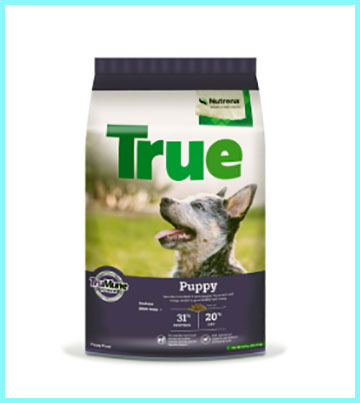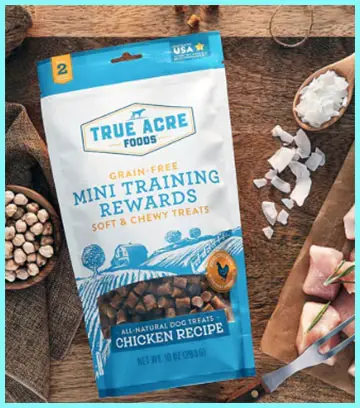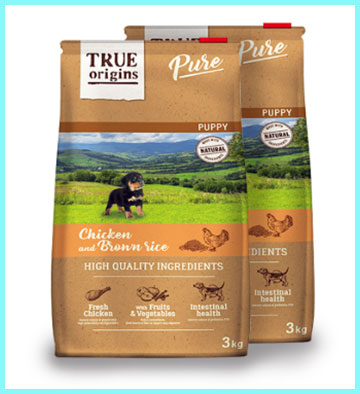Finding the right dog food can feel like a full-time job, and the sticker shock on premium brands is real. I was on a mission to find a high-quality, budget-friendly food, which led me straight to True Acre. It’s the brand you see everywhere on Chewy, promising real meat as the first ingredient at a price that seems too good to be true. If you’re like me and have been tempted by that promise, you need to read my story. This food has some serious pros, but you absolutely must know what you’re getting into.
My Experience With True Acre Dog Food
My journey with True Acre dog food started for the same reason I think most people’s does: price. I have a 60-pound goofball of a Golden Retriever mix named Buster, and that dog can eat. For years, I’d been shelling out a small fortune for one of those premium, vet-recommended, “science-backed” brands. My wallet was crying.

One day, while placing my (far too expensive) Chewy order, I saw True Acre.
The bag was bright, the marketing was on point, and the claims were exactly what I wanted to hear: “Farm-Raised Chicken, #1 Ingredient.”
And the price—it was almost half of what I was currently paying. I clicked on the “Grain-Free Chicken & Vegetable Recipe.”
The ingredient panel looked decent enough at a glance. I saw chicken, pea starch, and canola meal. “It’s grain-free, has real chicken… how bad can it be?” I thought. I added a bag to my Autoship, feeling smug about my savvy financial decision.
The bag arrived, and the transition began. I’m a responsible owner, so I didn’t just dump the new food in his bowl. I started the slow, 10-day transition: 25% new food, 75% old food. For the first three days, everything was great. Buster, who is not a picky eater, gobbled it up without a second thought. I was patting myself on the back. “See?” I told my skeptical wife, “He loves it. We’re saving a bundle.”
Then, we hit the 50/50 mark. The first sign of trouble was… the gas. I mean, room-clearing, paint-peeling gas. Buster had never been a gassy dog, but he suddenly became a one-dog chemical weapon. “His system is just adjusting,” I said, opening a window. But I was getting nervous.
By day seven, when we were at 75% True Acre, the real problems started. We woke up at 3 AM to the unmistakable sound of a dog about to be sick. We ran downstairs to find Buster in a state of serious gastrointestinal distress. He had horrible, explosive diarrhea all over the kitchen mat. It was that awful, watery, mustard-yellow kind that just screams “something is very wrong.” He was miserable, pacing and whining.
I stopped the True Acre immediately. We put him on a bland diet of boiled chicken and rice for three days to let his system reset. The diarrhea stopped, the gas went away, and he was back to his happy self. I was furious, but also confused. How could a food with “real chicken” as the first ingredient cause such a violent reaction?
I went back to the ingredient list, but this time I really read it. Chicken was #1, yes. But #2 was “Pea Starch.” #3 was “Canola Meal.” #4 was “Poultry By-Product Meal.” I fell down a research rabbit hole. The high amount of pea protein and other fillers was a common complaint. And “poultry by-product meal” is a non-specific, low-quality ingredient. It could be anything. It became clear: my dog, who has a stomach of steel for the pizza crusts and random street-treats he (regrettably) finds, could not handle the ingredient profile of this food. The formula, designed for a low price point, was just too harsh for his system. My “savvy financial decision” ended up costing me a new kitchen mat and a very bad night’s sleep.
Read More: Comparison Of Hill’s And Purina Pro Plan
Pros Of True Acre Dog Food
- Unbeatable Price And Accessibility: This is, without a doubt, the number one reason you’re looking at this food, and it’s a massive pro. This is a budget-friendly brand, period. It’s exclusively available on Chewy, which is incredibly convenient for most pet owners who are already using the platform. When I was shopping, the 40-lb bag was significantly less expensive than comparable bags from brands like Blue Buffalo, Taste of the Wild, or Purina Pro Plan. If you are on a tight budget or have multiple large-breed dogs, the math is compelling. The savings can add up to hundreds of dollars a year. This accessibility and affordability are what put True Acre on the map and make it a viable option for people who simply cannot afford a $100 bag of dog food every month. It’s a huge “pro” in the “real world” column.
- Real, Named Meat As The First Ingredient: This is the brand’s core marketing pillar, and they deliver on it. When you pick up the “Farm-Raised Chicken & Vegetable Recipe,” the very first ingredient listed is, in fact, Chicken. It’s not “chicken meal” (which is also good) or “poultry by-product meal” (which is not); it’s real, whole chicken. This is what dog owners have been trained to look for. We’re told “meat-first” is the gold standard, and True Acre checks that box. This means that, by weight, the most plentiful ingredient in the bag is a quality animal protein source. This is a huge step up from the old-school, bargain-basement brands you’d find at a corner store, which are often just a bag of corn with some meat flavoring. True Acre starts with a solid foundation, which is commendable for its price.
- Made In The USA: This is a big point of trust for many pet owners, myself included. We’ve all heard the horror stories about pet food safety standards (or lack thereof) in other countries. Knowing that True Acre dog food is made in the USA (specifically, in partner facilities in California) provides a significant level of peace of mind. It means the manufacturing process is subject to US labor laws, safety standards, and quality control regulations. While this doesn’t guarantee a perfect product (as my experience showed), it does mean there’s a level of oversight and accountability that you might not get from a product sourced and manufactured overseas. For many, “Made in the USA” is a non-negotiable, and True Acre meets that standard.
- Good Variety And Grain-Free Options: True Acre isn’t a one-trick pony. They offer a respectable range of products to fit different needs. I had chosen the grain-free option, but they also have grain-inclusive “Farmhouse Blends” for owners who (correctly, in my opinion) believe healthy grains like rice and barley are good for dogs. They have wet foods (stews and loaves), and they have a variety of treats. This means that if your dog does do well on the brand, you can stick with it and provide variety. The grain-free options are particularly appealing to owners whose dogs have confirmed grain allergies or sensitivities. It’s nice to see a budget brand offering these specialized formulas that are usually reserved for the premium market.
Cons Of True Acre Dog Food

- The Heavy Use Of Fillers And Split-Ingredients
- Peas And Pea Starch Are A Problem: This is what I missed on my first read-through. My dog’s grain-free formula had “Pea Starch” as the second ingredient. This is a classic example of “ingredient splitting.” While “Chicken” is #1, if you were to combine all the pea components (pea starch, pea protein, etc.), they would likely be the actual first ingredient in the bag. This is a way to make the label look more meat-heavy than it is.
- High In Carbs, Low In Meat (Relatively): These fillers, especially pea starch, are just cheap carbohydrates used to bind the kibble and keep costs down. They offer very little nutritional value to a dog and are a known culprit for digestive upset, gas, and large, chalky stools. My dog’s reaction was a classic sign of his system being overwhelmed by a sudden, massive influx of hard-to-digest plant-based fillers.
- The Use Of Low-Quality And Vague Ingredients
- “Poultry By-Product Meal”: This was the red flag I should have heeded. This was the #4 ingredient. What is “poultry by-product meal”? According to the AAFCO (the body that regulates pet food), it’s a rendered mix of “ground parts of the carcass of slaughtered poultry, such as necks, feet, undeveloped eggs and intestines.” But the key word is “poultry,” not “chicken.” This means it’s a mix from any bird—chicken, turkey, whatever is cheapest that day—and it’s the lowest-quality animal protein you can put in dog food.
- Canola Meal And Soybean Meal: These are other controversial, cheap fillers. They are the protein-rich “meal” left over after the oil has been pressed from canola seeds or soybeans. They are used to boost the protein percentage on the label, making it look like the food is richer in meat than it is. For many dogs, these ingredients can be allergens and cause skin issues or digestive upset.
- A Troubling Number Of Severe Customer Complaints
- My Experience Is Not Unique: After my 3 AM kitchen cleanup, I did what I should have done first: I read the 1-star Chewy reviews. I was shocked. It wasn’t just a few picky dogs. It was story after story that mirrored my own: “My dog has been on this for two weeks and has had non-stop, watery diarrhea.” “Woke up to vomit and diarrhea everywhere.” “My dog was hospitalized for GI distress.” “My vet told me to stop this food immediately.” I even saw some scary (though unconfirmed) claims of salmonella.
- A High-Risk Gamble: When the “pro” is “it’s cheap” and the “con” is “it might make your dog violently ill,” the gamble suddenly feels very unbalanced. The formula seems to be fine for some dogs, but for a significant and vocal minority, it is a digestive nightmare.
Maintenance Tips For True Acre Dog Food

- You Must Follow A 14-Day (Or Longer) Transition
- My 10-Day Transition Wasn’t Enough: My biggest mistake was being too aggressive. Because this food has such a different ingredient profile from most premium brands (high in pea-fillers, different protein sources), a dog’s gut microbiome needs a lot of time to adapt.
- The “Maintenance” Plan: If I were to ever try this again (which I won’t), I would do a minimum of a 14-day transition, and honestly, a 21-day one would be better. It would look like this:
- Days 1-5: 10% True Acre, 90% Old Food.
- Days 6-10: 25% True Acre, 75% Old Food.
- Days 11-15: 50% True Acre, 50% Old Food.
- Days 16-20: 75% True Acre, 25% Old Food.
- Day 21: 100% True Acre.
- Watch For The First Sign Of Trouble: At the first sign of watery stool, excessive gas, or a “gurgly” stomach, stop the transition. Go back to the previous, safer ratio for a few days before trying to increase again. If it happens a second time, abort the mission.
- Supplement With Probiotics And Digestive Enzymes
- Your Dog’s Gut Needs Help: This is not a “complete and balanced” food in the practical sense; it’s a food that is hard to digest. You absolutely must support your dog’s gut health.
- My Go-To Gut Stack: I recommend adding a high-quality, multi-strain probiotic powder to every meal. I’m a big fan of brands like Purina FortiFlora (which my vet recommends) or a good probiotic goat’s milk topper. This repopulates the gut with “good bacteria” to help break down the new ingredients.
- Add A Digestive Enzyme: A digestive enzyme (which often comes mixed in with probiotic powders) will help your dog break down the high-volume of plant-based proteins and carbohydrates that their system isn’t used to.
- Hydration Is Key
- This Kibble Is Dry And Chalky: One thing I noticed is that this kibble is very… dusty. It seems to suck the moisture out of everything. A dog on a food high in fillers like this is more prone to dehydration.
- Add Warm Water To The Bowl: My best tip is to add a quarter-cup of warm water (or, even better, low-sodium bone broth) to the kibble. Let it sit for a minute. This does three things: it makes the food more palatable, it forces your dog to take in more water, and it helps to pre-soften the kibble, making it slightly easier on the digestive tract.
- Buy The Smallest Bag First
- Do Not Commit To The 40-Lb Bag: This was my million-dollar mistake. I was so confident in my “deal” that I bought the giant bag. Now I have 38 pounds of dog food in my garage that I wouldn’t even donate (because I wouldn’t want to risk making another dog sick).
- Test Drive The 4-Lb Bag: Spend the extra money per-pound to buy the smallest possible bag from Chewy. Treat it as a “trial size.” Use that entire bag for your slow, 3-week transition. If your dog gets through that entire trial bag with no gas, no diarrhea, and no vomiting, then and only then should you consider graduating to the big bag.
Comparison With Other Brands

- Versus Premium, Vet-Recommended Brands
- True Acre vs. Purina Pro Plan: This is a night-and-day comparison. My dog is back on Purina Pro Plan Sensitive Skin & Stomach. When I look at the ingredients, I see “Salmon” (first) and “Rice” (second). It’s a simple, proven, and highly digestible formula. Purina Pro Plan invests millions in veterinary nutritionists and feeding trials. They have decades of research. True Acre is a “marketing brand” created by a retailer (Chewy) to fill a low-price slot. It is formulated to meet the minimum AAFCO standards. Pro Plan is formulated for optimal health. The Pro Plan costs twice as much, and as I learned, it’s worth every penny.
- Versus “Premium” Store Brands
- True Acre vs. Kirkland Signature: This is a more interesting comparison. Costco’s Kirkland Signature brand is also a budget-friendly store brand, and it is famous for its high quality. The Kirkland formulas (which are rumored to be made by the same company that makes Taste of the Wild) have a much better reputation. They use named “chicken meal” (a high-quality, concentrated protein source) instead of vague “poultry by-product meal.” Kirkland’s grain-inclusive formulas are highly respected by vets and owners. If I’m comparing budget brands, Kirkland’s reputation for quality control and better ingredients beats True Acre by a mile.
- Versus Other Budget-Friendly Brands
- True Acre vs. Pedigree: This is where True Acre shines. If your choice is between True Acre and a brand like Pedigree or Kibbles ‘n Bits, I would choose True Acre every single time. Why? Because those “grocery store” brands are often worse. Pedigree’s main ingredient is often “Ground Whole Corn,” with “Meat and Bone Meal” (another vague, low-quality ingredient) way down the list. True Acre’s “chicken-first” promise is a massive step up from a bag of corn. It’s a “premium” budget brand, and it blows the “classic” budget brands out of the water.
Also Read: Comparison Of Royal Canin And Nutro
Frequently Asked Questions (FAQ)
It’s an “okay” brand for its low price. It’s a budget-friendly food that uses real meat as the first ingredient, which is good. However, its heavy use of fillers (like pea starch) and low-quality by-products means Dog Food Advisor only gives it 3.5 stars and “recommends it with reservations.”
There is no single “#1” food for all dogs. The “healthiest” brands are those backed by scientific research, veterinary nutritionists, and feeding trials. Vets most commonly recommend brands like Hill’s Science Diet, Purina Pro Plan, and Royal Canin.
It is made in the United States, in partner facilities located in California. It is an exclusive brand for the online retailer Chewy.
While she hasn’t given a recent interview on it, reports and Dr. Marty Goldstein (a vet who has been on her show) strongly suggest she feeds her dogs Dr. Marty’s Nature’s Blend, which is a high-end, freeze-dried raw dog food.
Conclusion
So, who is True Acre for? After my disaster, I’ve had a lot of time to think about this. This food is not for a dog with even a slightly sensitive system. It is not for an owner who is unwilling to go through a long, slow, 3-week transition. But, if you have a dog with a cast-iron stomach and you are on an extremely tight budget, True Acre is a much better choice than old-school, corn-filled brands. But you are rolling the dice. For me, the savings were not worth the 3 AM cleanup. You should only buy this food if you’re prepared for the risk.
